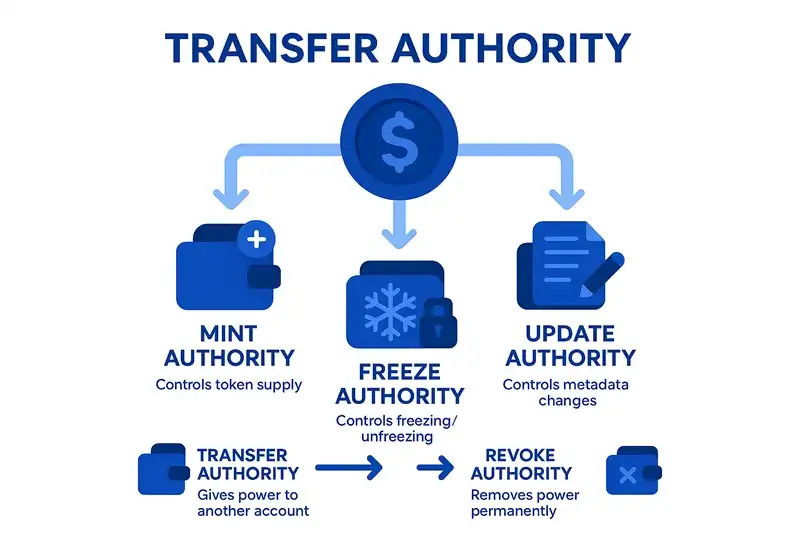Solana Transfer Authority
- DEXArea
- Wiki
- Solana
- Token Security
- Transfer Authority
Introduction
Transfer authority in Solana refers to the ability to transfer one of the three main token authorities (freeze, mint, or update) to another account. This is a powerful administrative function that allows token creators to delegate specific permissions to trusted parties.

Transfer Authority - Understanding Administrative Control Delegation on Solana
What is Transfer Authority?
Transfer authority is the permission to transfer administrative rights over a token to another account. In Solana’s SPL token standard, there are three main authorities that can be transferred:
- Freeze Authority: Controls the ability to freeze/unfreeze token accounts
- Mint Authority: Controls the ability to create new tokens
- Update Authority: Controls the ability to modify token metadata
When you transfer an authority, you’re essentially giving another account the power to perform specific administrative actions on your token.
How Transfer Authority Works
Authority Transfer Process
- Identify Target Authority: Choose which authority (freeze, mint, or update) you want to transfer
- Select Recipient: Choose the account that will receive the authority
- Execute Transfer: Use the appropriate instruction to transfer the authority
- Verification: Confirm the authority has been successfully transferred
Key Concepts
- Partial Delegation: You can transfer specific authorities while keeping others
- Complete Transfer: You can transfer all authorities to another account
- Revocation: Once transferred, you cannot reclaim the authority unless it’s transferred back to you
- Account Requirements: The recipient account must be a valid Solana account
Common Use Cases
Team Management
- Transfer mint authority to a treasury wallet for controlled token distribution
- Delegate freeze authority to a compliance officer for regulatory purposes
- Grant update authority to a marketing team for metadata management
Smart Contract Integration
- Transfer authorities to program-derived addresses (PDAs)
- Enable automated token management through smart contracts
- Delegate authority to DeFi protocols for specific functions
Business Operations
- Corporate governance and multi-signature requirements
- Employee access management
- Partnership and joint venture arrangements
Authority Transfer Comparison
| Authority Type | What It Controls | Common Transfer Scenarios |
|---|---|---|
| Freeze Authority | Freeze/unfreeze token accounts | Compliance teams, security officers |
| Mint Authority | Create new tokens | Treasury wallets, distribution contracts |
| Update Authority | Modify token metadata | Marketing teams, branding managers |
Security Considerations
Irreversible Action
Once you transfer an authority to another account, you cannot reclaim it unless that account transfers it back to you. Choose your recipients carefully.
Security Risk
Transferring authorities to untrusted accounts can result in loss of control over your token. Always verify the recipient’s identity and trustworthiness.
Best Practices
Before Transferring Authority
- Verify recipient identity thoroughly
- Use multisig wallets for enhanced security
- Test on devnet before mainnet execution
- Document all transfers for audit purposes
During Authority Transfer
- Double-check recipient address to avoid errors
- Use secure connections and verified tools
- Confirm transaction success on-chain
- Keep transfer records for future reference
After Authority Transfer
- Verify the transfer using blockchain explorers
- Update documentation to reflect new authority holders
- Monitor recipient activity for any suspicious behavior
- Maintain backup contacts with new authority holders
📝 Conclusion
Transfer authority is a powerful administrative function that allows you to delegate specific token permissions to other accounts. While this provides flexibility for team management and business operations, it also carries significant security implications.
Key Takeaways:
- Authority transfer is permanent - choose recipients wisely
- Verify all recipient accounts thoroughly before transfer
- Use multisig wallets for enhanced security when possible
- Document and monitor all authority transfers
- Test on devnet before mainnet execution
Always approach authority transfers with caution, verify recipient accounts thoroughly, and understand that these actions are typically irreversible. Maintain proper security practices to protect your token’s administrative control.
❓ FAQ
Q: Can I transfer multiple authorities at once?
A: Yes, you can transfer multiple authorities in a single transaction, but each authority transfer is a separate instruction. This allows for efficient batch processing of authority transfers.
Q: What happens if I transfer all authorities to another account?
A: If you transfer all authorities (freeze, mint, and update), you will lose all administrative control over your token. The recipient will have complete control and can modify, freeze, or mint tokens as they see fit.
Q: Can I transfer authority to a program (smart contract)?
A: Yes, you can transfer authority to a program-derived address (PDA) or smart contract. This is common in DeFi applications where automated logic needs to manage tokens.
Q: Is there a way to revoke transferred authority?
A: No, there is no built-in revocation mechanism. Once authority is transferred, only the recipient can transfer it back to you or to another account. This is why careful consideration is essential before transferring authorities.
Q: What’s the difference between delegating and transferring authority?
A: Delegation is temporary and can be revoked, while authority transfer is permanent and cannot be undone. Delegation is typically used for short-term access, while transfer is for long-term or permanent delegation.
📚 References and Further Reading
- Solana Token Program Documentation - Official token program guide
- SPL Token Program GitHub - Source code and specifications
- Solana Security Best Practices - Security guidelines
🔗 Related Topics
- Token Authorities - Overview of all token authorities
- Freeze Authority - Understanding freeze authority and how to manage it
- Mint Authority - Learn about mint authority and token creation permissions
- Update Authority - Understanding update authority and metadata management
